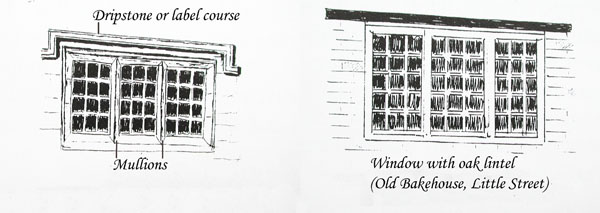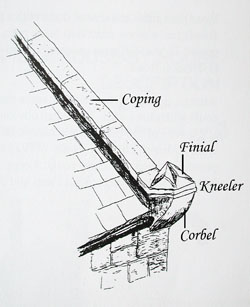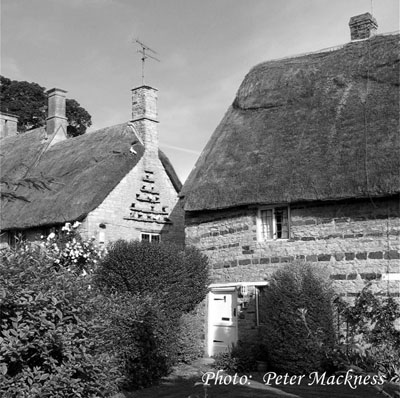
Harry's Cottage in Manor Road
THE ARCHITECTURE OF THE VILLAGE
(Back to Chapter 2 Index)
INTRODUCTION
In medieval times and until the end of the reign of Elizabeth I, the village of Sulgrave would have consisted in the main of wooden-framed houses, with wattle and daub infill. From the early 17th century, in a period of intense building activity, these dwellings were gradually replaced by stone houses, and of the earlier wooden structures no apparent trace remains. As the village stands on a ridge of oolitic limestone, building material was close at hand - this was fortunate, transport in those days being very difficult. Some of the stone was obtained from the immediate vicinity; at least two small quarries existed, one of which can easily be identified in the field known as Clay Pits, or Mortar Pits, to the right of the Magpie road as one leaves the village. Unfortunately, this Sulgrave stone, from the Lower Lias, was full of fossils and very hard, and therefore difficult to cut into shape. The stones were sometimes used "as picked up" in walls of random rubble; sometimes having been "rough chopped" (that is, having had the edges knocked off), they were laid in rough courses; and somtimes they were chopped clean and laid in even courses. There was however at Helmdon a larger quarry where the limestone was from the Upper Lias and more suitable for the cutting of "ashlar". This is the name given to blocks of stone which have been cut squarely and evenly, and which were often used for cornerstones, chimneys and window dressings, and sometimes for the facades of houses of better quality.
By the end of the 18th century, therefore, Sulgrave had already taken up its figure-of-eight layout, compact, with even the farmhouses situated in the village itself rather than in more isolated positions as in other areas. It was in essence a village of houses built in this local pale grey limestone. However, a short distance to the west is an area, centred on Banbury, where there occurs a limestone of the Middle Lias, sandy in texture and of a darker reddish-brown colour. This "marlstone" or "ironstone", usually quarried at Eydon or Hornton, was frequently used in this and neighbouring villages as an embellishment. Hornton stone is darker than that from Eydon; there is also a Hornton stone of a grey-blue colour which was used chiefly for flagstones and paving. The brownstones are seen as dressings to windows, doors and quoins (corner-pieces), and as gable-parapets. An interesting use of this dark stone is in more or less regularly spaced courses so as to provide alternate horizontal stripes of light and dark stone - Manor Cottage and Harry's cottage offer examples. There are one or two instances, such as the Six Bells, of houses constructed mainly from the dark red Eydon "sandstone".

Harry's Cottage in Manor Road
During the 17th and 18th centuries, roofs generally were thatched with wheatstraw. Occasionally, as in the case of Sulgrave Manor, stone slates either from Stonesfield in Oxfordshire or Collyweston, in the north of Northamptonshire, were used.

These limestone slates were dug out of the quarries in thick cakes and left through the winter for the frost to split them into thin plates. Obviously, they were much more costly than the local straw.
Other features characteristic of the local vernacular style are worth mentioning. Windows of the period were usually wood-framed, with a narrow oak lintel extending sideways  beyond the window itself, but sometimes were dressed in stone, with a dripstone above in the form of a "label-moulding".
beyond the window itself, but sometimes were dressed in stone, with a dripstone above in the form of a "label-moulding".
Some of the houses had very steeply pitched roofs - the Old Forge House is an example. It is interesting that this feature has been carried forward into houses of very recent construction, including the newest (1991). In some cases, the gables of houses with thatched roofs were raised to form parapets, with coping stones; the parapets were supported at the eaves by corbels, and over the corbels were often "kneelers" on which stood small finials. These finials are usually of a similar pattern, and one assumes that they were carved by the local stonemason. Most of the thatched roofs have gone, but the stone parapets and other features remain. The Reading Room (the Old School) provides an easily-observed example.
With the improved transport conditions of the late 18th and early 19th centuries, building materials from outside the immediate area gradually came to be used. Bricks, for example, long used in neighbouring Warwickshire, were widely employed in the construction of new houses and in the enlargement and renovation of older properties. In the days before planning controls, little attempt was made to match new materials with the old, and it is common to see, within one building, stone of different types alongside various kinds of brick. Thus Wisteria Cottage (Helmdon Road) has sides and rear of stone with a frontage of brick; the Old Bakehouse (Manor Road) has a stone front and brick rear; whilst a whole history of alterations can be traced in the different materials used in The Cottage and adjacent Burnbrae (Helmdon Road).
Along with the advent of brick came the re-covering of most of the original thatched roofs with blue slates. These had obvious advantages in terms of safety and economy, but lovers of the picturesque cannot help regretting the disappearance of the thatch from so many houses. Today (1992) only six of the properties in the village have preserved their thatched roofs: Forge Cottage, Dial House, The Thatched House Hotel, Manor Cottage, Kiln Farm and Rectory Farm.

Manor Cottage and The Thatched House Hotel.
Notice dovecotes on the end of the latter.
During the 20th century, many of the old cottages have been demolished, or combined with others to form larger untis. Planning restrictions have put great value on building land, and plots have been sub-divided to provide room for new houses. Present-day dwellings are on the whole much larger than the old ones, but accommodate smaller families; Sulgrave's population in 1821 was 578, shrinking to 380 by 1920 and to about 350 today.
This period has seen also the increased use of 'alien' materials, brick of all hues, reconstituted stone blocks, roof tiles, window frames made from tropical hardwood or anodised aluminium.....the list is endless, and some of the more newly built houses are identical with those to be seen on the outskirts of Dorking, or Droitwich or Durham. However, there does appear to be a recent tendency to recreate at least some of the traditional features which gave the old Sulgrave its air of belonging to South Northamptonshire and nowhere else.